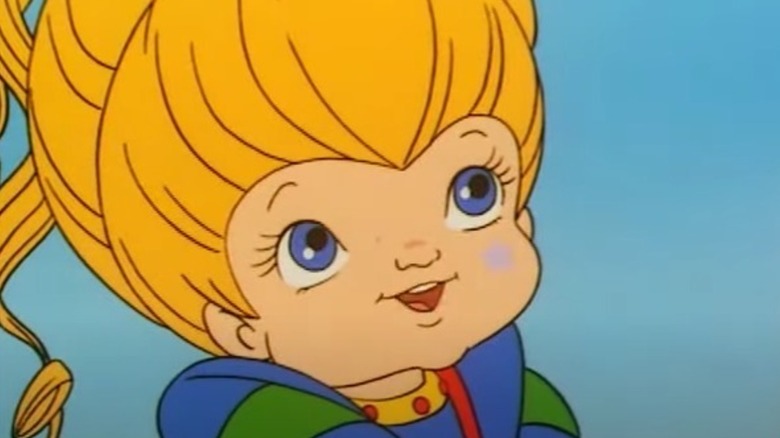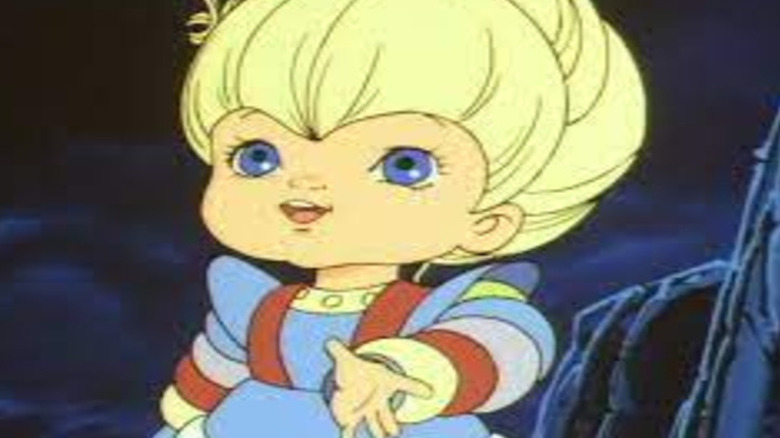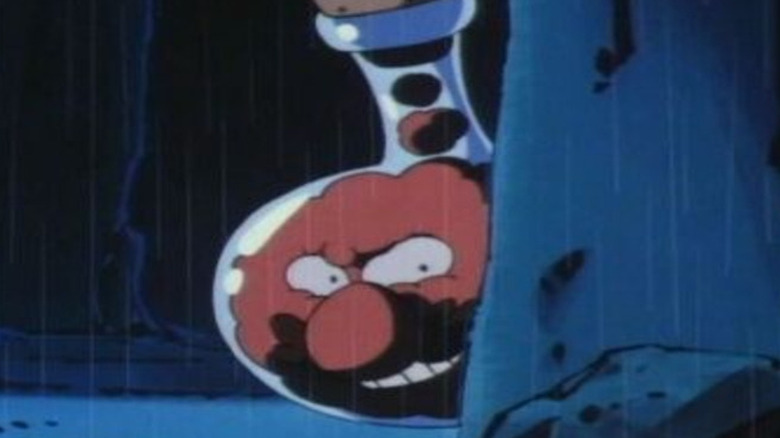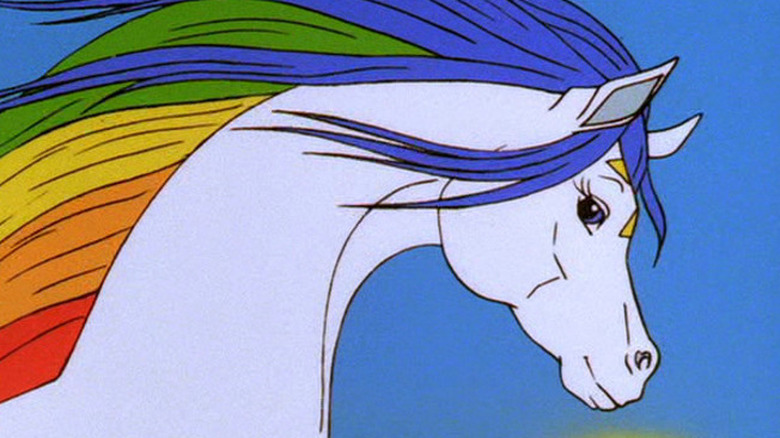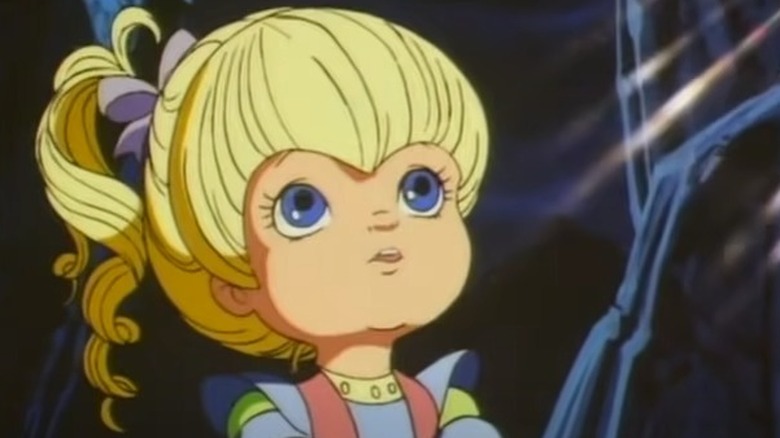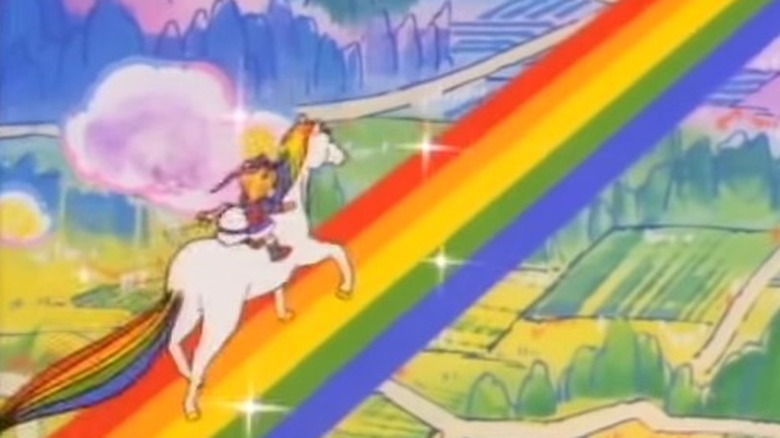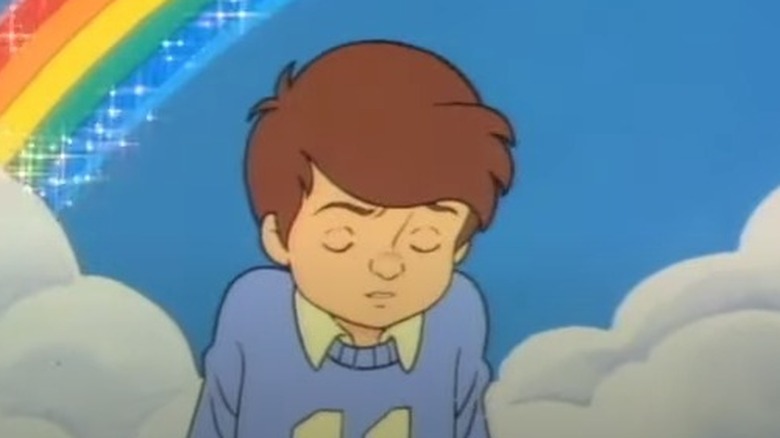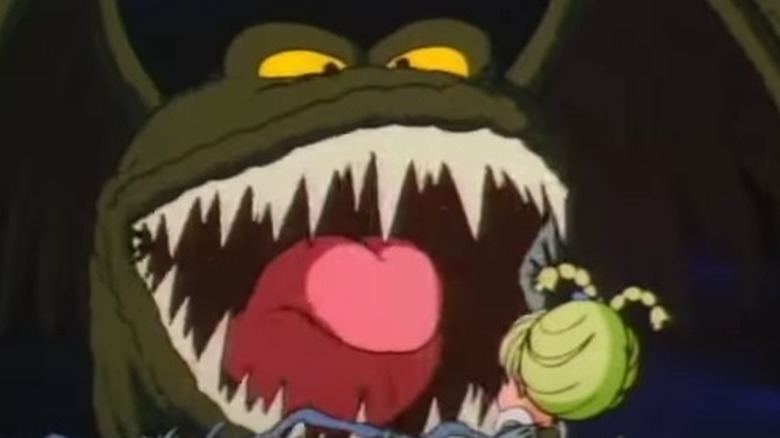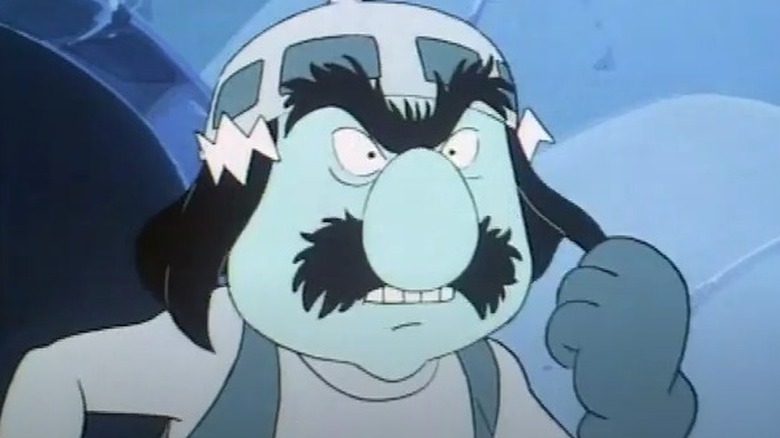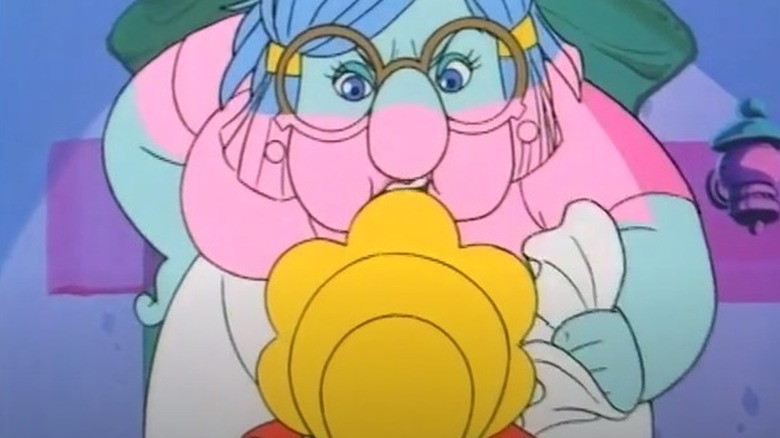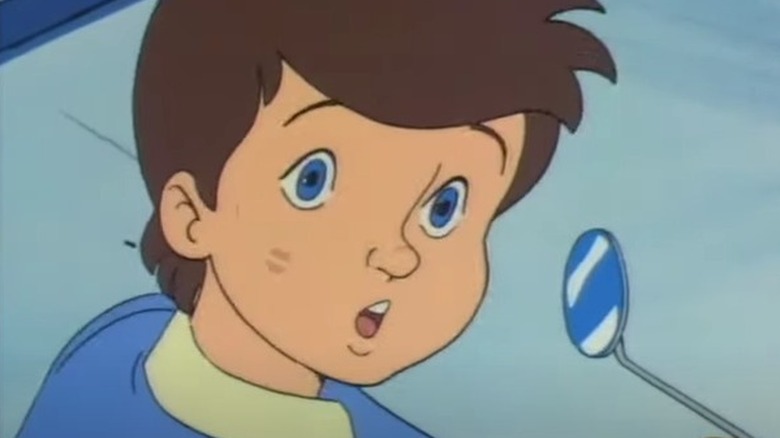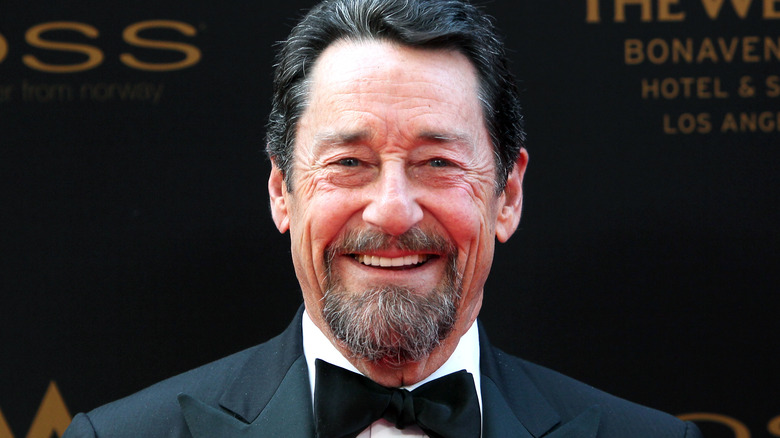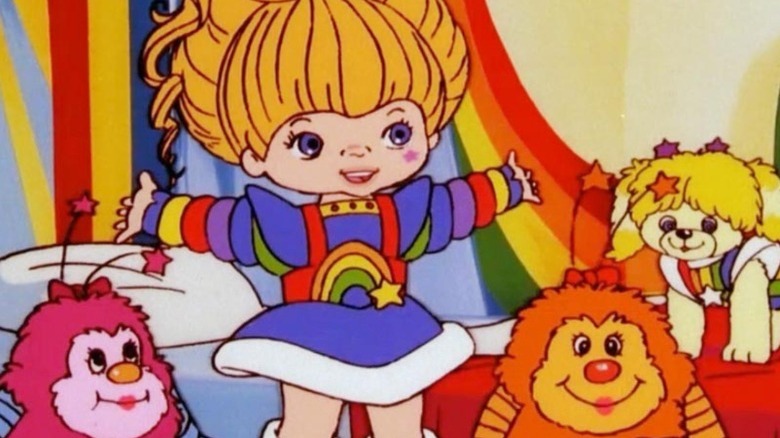Things Only Adults Notice In Rainbow Brite
You might remember "Rainbow Brite" as the kitschy little cartoon that didn't survive long after the 1980s ended. Created by Hallmark Cards in 1984, the original "Rainbow Brite" spread love and joy through toys, videos, books, and a ton of other media during the '80s, as remembered by The Huffington Post. Aside from a 2014 reboot, it hasn't had much of a presence in popular culture over the last four decades. This can make "Rainbow Brite" easy to dismiss as just another kid's cartoon designed to sell products with seemingly little redeeming value other than to keep the children of the '80s distracted and out of trouble.
Is that true, though? Is there nothing more to the show than what adolescent children can easily understand? Taking another look at the series almost forty years later proves otherwise. This story about a little girl named Wisp protecting Rainbow Land from the machinations of a color-hating goon has hidden treasures below its simple surface. Here is just a handful of things only adults notice in "Rainbow Brite."
No time to waste
One would think that if you're setting a story in an entirely fictional world, it might be wise to give the audience some time to acclimate to these strange surroundings. Even "Star Wars" offers the viewer a minute to breathe after C3PO and R2D2 land on Tatooine, as it takes a while for them to be captured by the Jawas and sold to Luke Skywalker. This allows viewers to take in the landscape and become a little acclimated to the nature of this galaxy far, far away. "Rainbow Brite" does not do this.
We see a treacherous landscape of jagged mountains and darkness. Adorable creatures run for their lives from the dangers of this terrible place. Then, from the sky, there comes a light. Where it lands, there now stands a little girl clad in rainbow colors. This is Wisp, and her mission is to bring light and beauty back to this terrifying world. Getting to that point takes about two minutes in the series opener. From there, Wisp is on the move, making friends, defeating enemies, and demanding that her young audience keeps up. Should the action stop for an infodump about Wisp's origin? Nope! Her work is far too important for that.
From Masters of the Universe to Care Bears
There were so many animated adventure shows trying to sell toys in the '80s that they were bound to start resembling each other. One year before the premiere of "Rainbow Brite," 1983, saw the television debut of "He-Man and the Masters of the Universe." That series tells the story of He-Man, who fights to protect Castle Greyskull from Skeletor and friends in Eternia, a bizarrely dark landscape with spots of color. The show's concept is similar to Rainbow Brite's mission, and the world's geography is remarkably like the foreboding area surrounding Rainbow Land.
In 1985, one year after "Rainbow Brite" hit TV screens, viewers were introduced to the "Care Bears" series. Unlike "He-Man," this series wasn't concerned with fighting literal monsters with a powerful sword, it was more interested in the power of emotions to save the day. The Care Bears themselves live in the clouds in a colorful kingdom that bears a strong resemblance to Rainbow Land itself.
For kids at the time, it must've just seemed like a golden age of heroes giving their all to help people by using their unique abilities. For an adult in the 21st century, one can't help but see "Rainbow Brite" as the bridge between the two shows. She fought scary monsters, like He-Man, but did so with positivity like the Care Bears.
Starlite is kind of conceited
Magical horses are always great. Even Greek mythology had Pegasus, a supernaturally gifted horse capable of flight that often assisted heroes on their quests. In some ways, they could be considered the fantasy genre's equivalent to technologically advanced cars in science-fiction, such as KITT from "Knight Rider." They're more than a means of conveyance — they're trusted friends. In the case of Rainbow Brite's valiant steed Starlite, they can also be incredibly full of themselves.
One of the many creatures saved by Wisp in the opening two-parter, Starlite is often by her side. With his colorful mane, star mark on his forehead, and the rainbow path that forms beneath his feet, he is an undeniably impressive companion. Beyond that, Starlite often has to pull off some pretty daring stunts to keep his friends alive. However, he's also pretty chatty, and one of his favorite subjects is just how great he is. If there is anyone who isn't aware of how heroic and amazing he is, don't worry — he will make sure to tell you.
While kids may not have seen this character trait as anything more than a hero acting heroic, adults will instantly recognize Starlite's conceited behavior as a quirky and humorous idiosyncrasy.
The animation is mostly great
This is something kids may have noticed but probably never dwelled on. The quality of animation from the 1980s is all over the map. Shows like "He-Man and the Masters of the Universe" might look great when everyone's standing around but often look pretty silly once the action starts. "Thundercats" has an incredible title sequence, but the episodes themselves often didn't live up to the standard that it sets. "Rainbow Brite" occupies a curious space in the middle.
Everything involving the Pits surrounding Rainbow Land is atmospheric, fast, and dynamic. The characters are detailed with animation that is mostly fluid and natural. Rainbow Land, however, often looks partially unfinished. Scenes of Wisp and Starlite charging across the sky are always epic, but the landscape below them is so simple one has to wonder what the intention was. Were they hoping to make it look like something out of a child's coloring book, or were they trying to crank these episodes out so quickly that they didn't have time to worry about that sort of thing?
Again, the target audience was likely too wrapped up in the excitement to notice, but that small inconsistency really stands out for adults today.
Keeping peace and harmony takes work
Given the general simplicity of "Rainbow Brite," it would be easy to end every episode with "and the residents of Rainbow Land lived happily ever after." The show didn't do that, though. One could assume that the reason for this was to continue telling stories that would sell more merchandise. If Rainbow Land never faced a problem again, that would make for a pretty boring franchise. While that may be true, the conclusion of "Beginning of Rainbowland: Part 2" suggests a moral which may have been unintentional but is important nonetheless.
After finding the sphere of light and banishing the darkness, color and beauty return to Rainbow Land. The light that sent Wisp to this place congratulates her on the victory and states she will now be known as Rainbow Brite. The story could've ended there and been satisfying. Instead, the light continues, telling Rainbow Brite that as wonderful as this all is, there are going to be people trying to screw it up. As such, she must remain vigilant to keep everyone safe.
The message that struggles and challenges don't end after utopia has been achieved is a pretty heady one for kids to handle. However, it's important to instill in people of all ages and will always be relevant.
Emotions are complicated
Rainbow Brite's whole thing is the power of positivity. She wants to go around spreading joy to the masses to keep the darkness and gloom away. That's not exactly a practical goal, and the show seems to subtly acknowledge this at times.
Perhaps the best example is seen in a human boy from Earth named Brian. He's all bummed because he didn't make the team. He feels so down that even the adorable yapping of his dog, Sam, doesn't rouse him. Rainbow Brite and Starlite create gorgeous rainbows all over the sky, hoping that he'll see them and feel better, but it doesn't work. Even when this magical duo reveals themselves to the kid and takes him to Rainbow Land, he's still hurt.
Of course, by the end of their adventure, the team finds a way to make Brian feel better, but it takes a lot to get him there. It doesn't matter how cheerful or beautiful something is. When someone is truly hurting, they can't simply will themselves into a better mood. Even if they do, there's no guarantee that they'll remain that way forever. Even in the whimsical world of "Rainbow Brite," life is tough, and happiness takes work.
A unique tone
Something that stands out to adults right about "Rainbow Brite" is its tone. This is a show about magical children in a place called Rainbow Land. Shouldn't it all just be an adorable distraction for kids younger than six? Well, that's a fair assumption, but it's also completely wrong.
This show isn't afraid to get scary. Sure, some of the monsters are silly goofballs, but others are genuinely menacing. During the opening two-parter, Wisp is always about to either be eaten by something, burned to death, or plummet to her demise. Many of the monsters don't simply want to inconvenience the hero. They want to cause actual harm. Even the recurring villains Murky and Lurky, who are total idiots, pose a very real threat to these lighthearted characters. Murky, in particular, wants to wipe out all positivity from existence, and that's pretty grim stuff for an otherwise happy little show.
Danny DeVito would make a great murky
Animated shows from the '80s were only as good as their villains. "He-Man and the Masters of the Universe" had Skeletor. "Teenage Mutant Ninja Turtles" had Shredder. "The Transformers" battled Megatron. Rainbow Brite's nemesis is a short, angry man named Murky. He and his oafish companion Lurky are trying to eliminate all the color and happiness in Rainbow Land. His size, demeanor, and outlook on life feel like it would be the perfect role for one Danny DeVito.
DeVito has made quite a career out of playing unlikable jerks. From the angry dispatcher Louie De Palma on "Taxi" to the sleazy Frank Reynolds in "It's Always Sunny in Philadelphia," DeVito excels at depicting the despicable. Many of the characters in "Rainbow Brite" are so stylized and unrealistic that imagining a human actor playing the role can be difficult. However, when it comes to Murky, he's so close to DeVito that one can't help but wonder why the actor got a call to play the Lorax many years later but never got one for this mustachioed creep.
Child shaming makes a monster
Audiences learned Murky's secret origin in an episode titled "Mom." Murky's mother shows up, and he pretends to be the ruler of Rainbow Land to impress her. At one point, his overbearing mother reminisces on Murky's early love for color, and we are treated to a surreal flashback that explains his entire backstory.
It's brief and played for laughs, but it actually gives incredible insight into Murky's character. We see a very young Murky, who is already sporting a mustache, painting and drawing all over the walls as his mother does the dishes. When she enters the room and discovers the mess he has created, she loses it. She gets down in his face and says that he is going to get rid of all this color, even "if it takes you the rest of your life!"
The shame he feels while suffering his mother's wrath sets him down a very dark path. Although she didn't mean to traumatize him, she is clearly responsible for the terrible things he's done. Strangely, this is never addressed at any point. Instead, Mom teams up with Rainbow Brite to defeat Murky, calling him her "no good son." Kids may have sympathized with her actions, but to older viewers, her toxic treatment of her son makes her the true villain of the series.
Brian is more interesting than he appears
As discussed earlier, Brian is taken to Rainbow Land because he feels down after he doesn't make the team. It takes an entire episode, but he eventually cheers up. Given the episodic nature of the series, it would've been perfectly fine if we never saw him again. However, he becomes something of a regular. Does he return as a flawless character who has been permanently cured by Rainbow Brite's infectious optimism? Not at all.
Returning to the theme of feelings being complicated, Brian's life isn't automatically better. One of the next times we see him, he's stressed out from delivering newspapers. When Wisp offers to help him, he gets all snotty, saying he doesn't need a girl's help. At first, when she offers him a chance to return to Rainbow Land, he scoffs, saying that he probably doesn't have enough time. While back in Rainbow Land, he's constantly trying to be cooler than the color kid, Red Butler. What is Brian's deal?
Only after considering the overall message of the series does his attitude make sense. He's supposed to be a real person dealing with the challenges of real life. This means sometimes he's on top of the world, while other times he's full of anger and bitterness. That isn't an inconsistency, it's a commendable dramatic choice. Without explicitly saying it, the show demonstrates that we are all works in progress and there's no magical cure for what ails us but time combined with perseverance.
Voice acting legends
In some ways, voice acting can be more difficult than acting on-camera. While actors in front of the camera can rely on their facial expressions and body language to communicate a character's inner life, actors doing animation only have their voices. Hopefully, the folks responsible for the animation can create visuals that support the vocal performance, but that's not always guaranteed. This means that voice actors have to take a leap of faith and give it their all every single time.
The voice cast of "Rainbow Brite" boasts some pretty legendary names. Murky and Lurky, for instance, are portrayed by Peter Cullen and Pat Fraley. You might recognize Cullen as Optimus Prime in "Transformers," or Eeyore in "Pooh's Heffalump Movie," or one of his hundreds of other voice acting credits. Fraley might be best known as Krang in "Teenage Mutant Ninja Turtles," but he also played Cousin It in "The Addams Family" and a ridiculous amount of other characters. Then there's Brian, voiced by Scott Menville, who later played Robin in "Teen Titans" and "Teen Titans: Go!" These three, and much of the remaining cast, have been shaping childhoods for decades.
Rainbow Brite is still important
Fairly quickly into the premiere episodes of "Rainbow Brite," one wonders if the show is really about using the power of colors to make people happy. The show's depths become clearer upon further viewing, but that whole mystery about colors still sticks. Then something clicks, and the show's overall relevance shines just a bright as the main character herself.
This is a show about perseverance in the face of doom. It's about standing up to the darkness that threatens to consume all of us and telling it no. The color kids and the sprites are more than just innocent creatures that need to be protected from the forces of darkness. They are individuals working together to maintain the peace and harmony that Rainbow Brite has worked so hard to achieve.
More than that, "Rainbow Brite" is a show about all the good that can be done when people of all kinds open their hearts and refuse to let the things that divide them also define them. The light and beauty the show is always talking about isn't necessarily an actual rainbow. It's what the rainbow represents. Against all odds, this little show created by a greeting card company is still relevant for adults today because it reminds us that diversity is both beautiful and essential.
